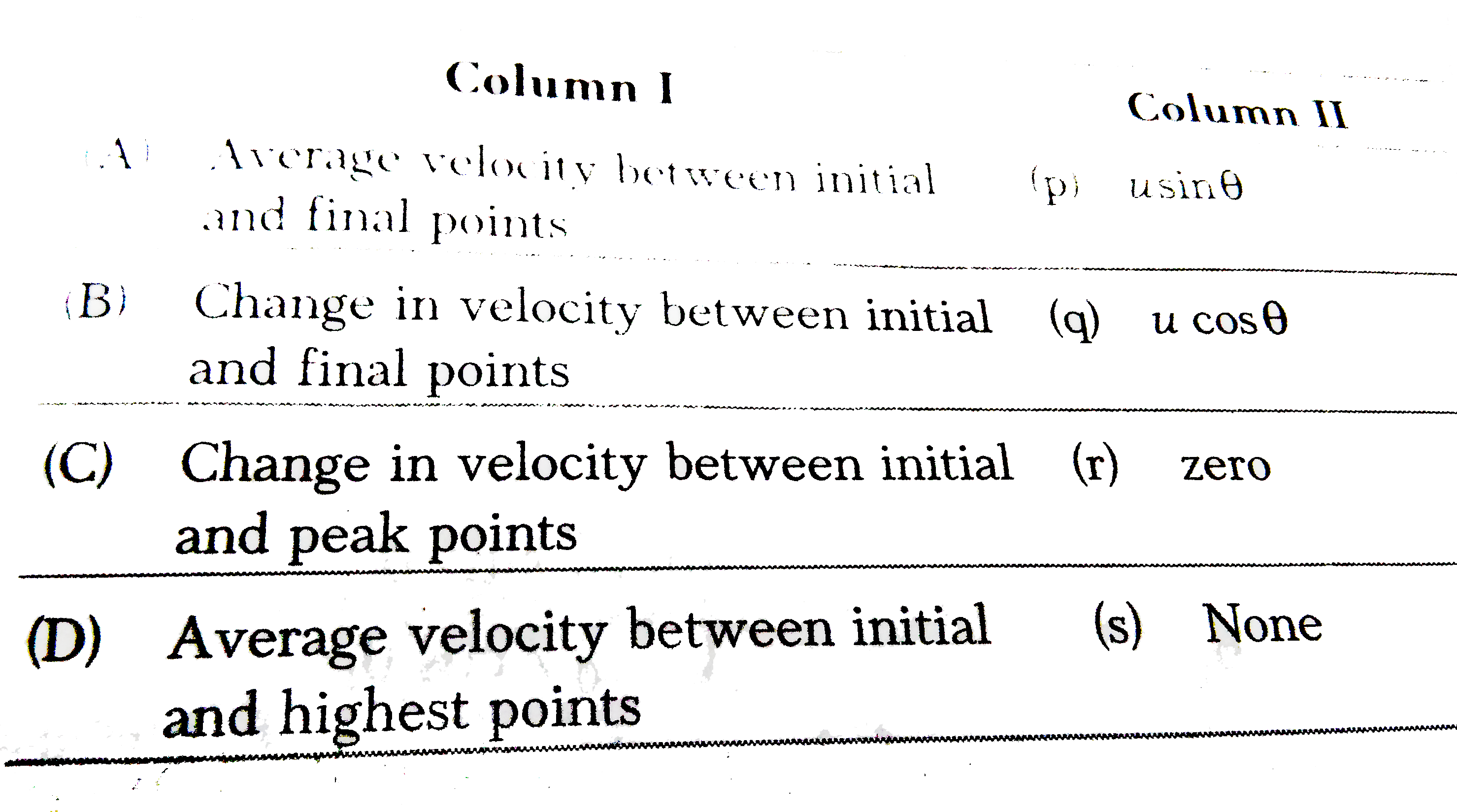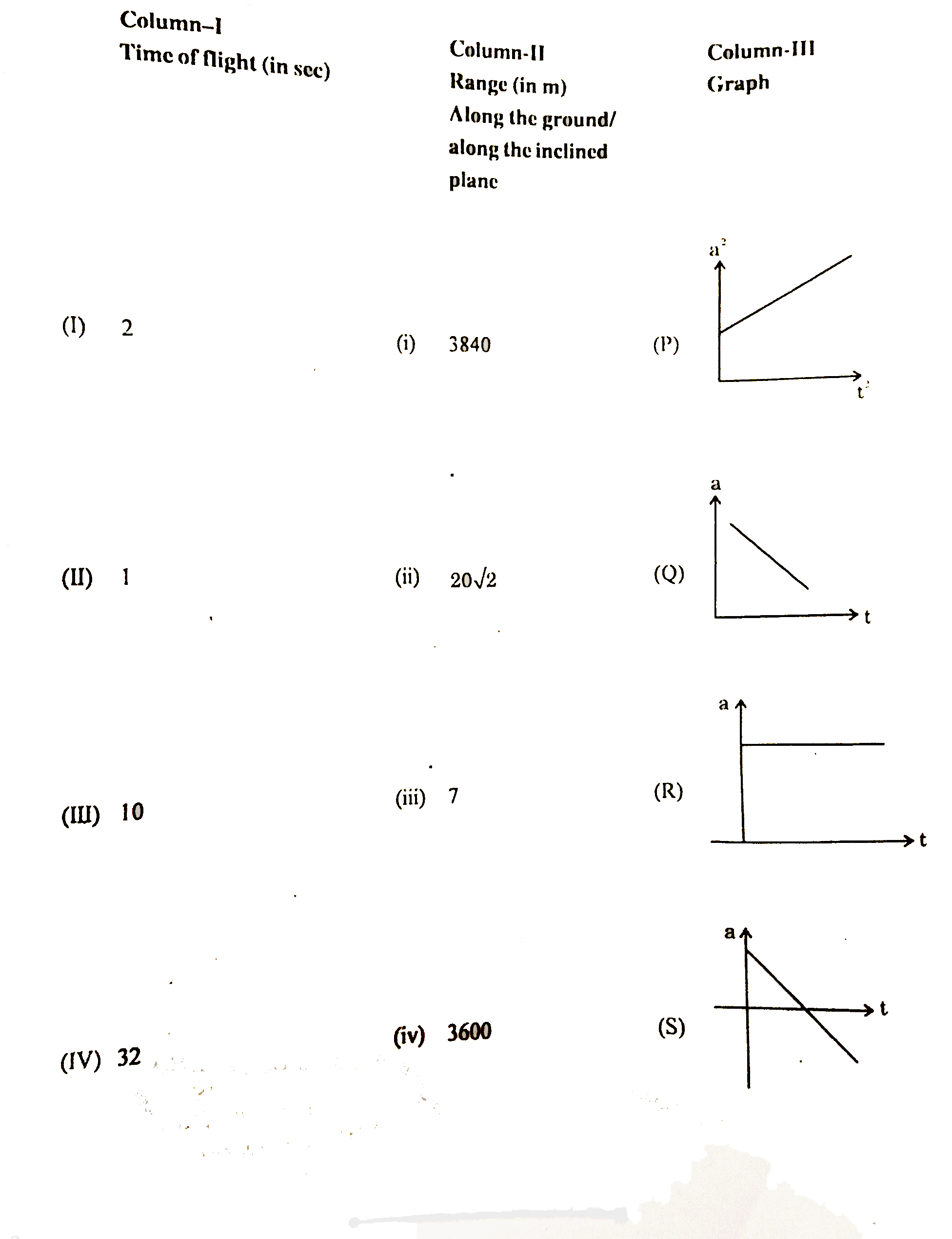A particle is projected with velocity u at angle θ with horizontal. Find the time when velocity vector is perpendicular to initial velocity vector.
The correct Answer is:A, C
To solve the problem of finding the time when the velocity vector of a projectile is perpendicular to its initial velocity vector, we can follow these steps:
Step 1: Resolve the Initial Velocity
The initial velocity u can be resolved into its horizontal and vertical components:
- Horizontal component: ux=ucosθ
- Vertical component: uy=usinθ
Step 2: Write the Expression for Final Velocity
The final velocity v of the projectile at time t can be expressed as:
v=ux^i+(uy−gt)^j
Substituting the components:
v=(ucosθ)^i+(usinθ−gt)^j
Step 3: Condition for Perpendicular Vectors
For the velocity vector v to be perpendicular to the initial velocity vector u, their dot product must be zero:
u⋅v=0
Substituting the vectors:
(ucosθ^i+usinθ^j)⋅((ucosθ)^i+(usinθ−gt)^j)=0
Step 4: Expand the Dot Product
Calculating the dot product:
(ucosθ)(ucosθ)+(usinθ)(usinθ−gt)=0
This simplifies to:
u2cos2θ+usinθ(usinθ−gt)=0
Step 5: Simplify the Equation
Expanding the second term:
u2cos2θ+u2sin2θ−ugtsinθ=0
Using the identity cos2θ+sin2θ=1:
u2−ugtsinθ=0
Step 6: Solve for Time t
Rearranging the equation gives:
ugtsinθ=u2
Dividing both sides by ugsinθ (assuming u≠0 and sinθ≠0):
t=ugsinθ
Final Answer
Thus, the time when the velocity vector is perpendicular to the initial velocity vector is:
t=ugsinθ
---
The initial velocity u can be resolved into its horizontal and vertical components:
- Horizontal component: ux=ucosθ
- Vertical component: uy=usinθ
The final velocity v of the projectile at time t can be expressed as:
v=ux^i+(uy−gt)^j
Substituting the components:
v=(ucosθ)^i+(usinθ−gt)^j
For the velocity vector v to be perpendicular to the initial velocity vector u, their dot product must be zero:
u⋅v=0
Substituting the vectors:
(ucosθ^i+usinθ^j)⋅((ucosθ)^i+(usinθ−gt)^j)=0
Calculating the dot product:
(ucosθ)(ucosθ)+(usinθ)(usinθ−gt)=0
This simplifies to:
u2cos2θ+usinθ(usinθ−gt)=0
Expanding the second term:
u2cos2θ+u2sin2θ−ugtsinθ=0
Using the identity cos2θ+sin2θ=1:
u2−ugtsinθ=0
Rearranging the equation gives:
ugtsinθ=u2
Dividing both sides by ugsinθ (assuming u≠0 and sinθ≠0):
t=ugsinθ
Thus, the time when the velocity vector is perpendicular to the initial velocity vector is:
t=ugsinθ
Topper's Solved these Questions
- PROJECTILE MOTIONBOOK - DC PANDEY ENGLISHCHAPTER - PROJECTILE MOTIONEXERCISE - Example Type 1
1 Videos
- PROJECTILE MOTIONBOOK - DC PANDEY ENGLISHCHAPTER - PROJECTILE MOTIONEXERCISE - Example Type 2
1 Videos
- MOTION IN A PLANEBOOK - DC PANDEY ENGLISHCHAPTER - MOTION IN A PLANEEXERCISE - (C )Medical entrances gallery
32 Videos
- PROPERTIES OF MATTERBOOK - DC PANDEY ENGLISHCHAPTER - PROPERTIES OF MATTEREXERCISE - Integer
8 Videos
Similar Questions
A particle is projected with a velocity u making an angle θ with the horizontal. At any instant its velocity becomes v which is perpendicular to the initial velocity u. Then v is
View SolutionA particle is projected with velocity v at an angle θ aith horizontal. The average angle velocity of the particle from the point of projection to impact equals
View SolutionA particle is projected form ground with velocity u ar angle θ from horizontal. Match the following two columns.

View SolutionMatch the following

In groung to ground projection a particle is projected at 53∘ from horizontal. At t=25 sec after projection, its velocity vector becomes perpendicular to its initial velocity vector.
(Given →a=g⏐↓=10m/s2)
View SolutionA particle is fired with velocity u making angle θ with the horizontal.What is the change in velocity when it is at the highest point?
View SolutionA particle is projected at an angle θ with an initial speed u.
View SolutionA particle is projected at an angle θ=30∘ with the horizontal, with a velocity of 10ms−1. Then
View SolutionA particle of mass m is projected with velocity u at an angle α with horizontal. During the period when the particle descends from highest point to the position where
its velocity vector makes an angle α2 with horizontal. Work done by gravity force is
View SolutionA particle is projected with velocity 'u' makes an angle θ w.r.t. horizontal. Now it breaks in two identical parts at highest point of trajectory. If one part is retrace its path, then velocity of other part is -
View SolutionA particle is projected at t=0 with velocity u at angle θ with the horizontal. Then the ratio of the tangential acceleration and the radius of curvature at the point of projection is :
View Solution
